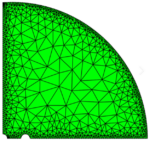You might not immediately see a connection between semiconductor substrate choices and inference at the edge. These technology layers seem worlds apart and yet SOITEC have a point. Edge AI has rapidly evolved from simple CNNs to now complex reinforcement learning systems and transformer based LLMs. Even when shrunk to edge footprints,… Read More
Tag: bernard murphy
Expedera Proposes Stable Diffusion as Benchmark for Edge Hardware for AI
A recent TechSpot article suggests that Apple is moving cautiously towards release of some kind of generative AI, possibly with iOS 18 and A17 Pro. This is interesting not just for Apple users like me but also for broader validation of a real mobile opportunity for generative AI. Which honestly had not seemed like a given, for multiple… Read More
Cadence Claims the CFD High Ground with a New GPU-Based Accelerator
For observers of EDA markets there is an easily overlooked opportunity for new growth. Today around 50% of EDA revenues come from systems rather than semiconductor companies, from datacenters to automotive, aerospace, energy, and others. In most of these industries total system design depends as much on mechanical and other… Read More
2023 Retrospective. Innovation in Verification
As usual in January we start with a look back at the papers we reviewed last year. Paul Cunningham (GM, Verification at Cadence), Raúl Camposano (Silicon Catalyst, entrepreneur, former Synopsys CTO and now Silvaco CTO) and I continue our series on research ideas. As always, feedback welcome. We’re planning on starting a live series… Read More
Blending Finite Element Methods and ML
Finite element methods for analysis crop up in many domains in electronic system design: mechanical stress analysis in multi-die systems, thermal analysis as a counterpart to both cooling and stress analysis (eg warping) and electromagnetic compliance analysis. (Computational fluid dynamics – CFD – is a different beast which… Read More
An Accellera Functional Safety Update
In May of 2021 Accellera released a first white paper on the challenges they hope to address with their functional safety standard, together with the scope and goals they set for themselves. One major goal in this effort has been exchange and integration of functional safety data between different tools and flow and particularly… Read More
Information Flow Tracking at RTL. Innovation in Verification
Explicit and implicit sneak paths to leak or compromise information continue to represent a threat to security. This paper looks a refinement of existing gate level information flow tracking (IFT) techniques extended to RTL, encouraging early-stage security optimization. Paul Cunningham (Senior VP/GM, Verification at … Read More
Reasoning and Planning as the Next Big Thing in AI
When I search for ‘what is the next big thing in AI?’ I find a variety of suggestions around refining and better productizing what we already know. Very understandable for any venture aiming to monetize innovation in the near term, but I am more interested in where AI can move outside the box, to solve problems well outside the purview… Read More
When Will Structured Assembly Cross the Chasm?
First, a quick definition. By “structured assembly,” I mean the collection of tools to support IP packaging with standardized interfaces, SoC integration based on those IPs together with bus fabric and other connectivity hookups, register definition and management in support of hardware/software interface definition, … Read More
5G Aim at LEO Satellites Will Stimulate Growth and Competition
Low earth orbit (LEO) satellites as an intermediary for communication became hot when Elon Musk announced Starlink (yeah, other options were available, but Elon Musk). This capability extends internet availability to remote areas and notably (for a while) to Ukraine in support of the war with Russia. Satellites can in principle… Read More










